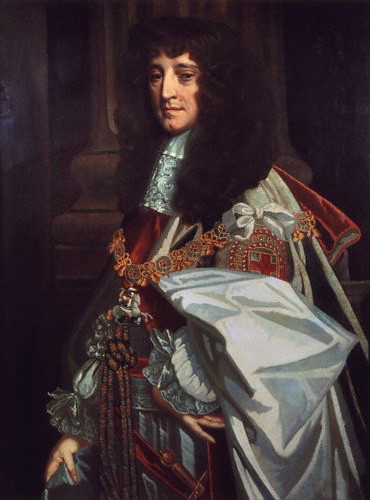Prince Rupert
Prince Rupert (also called Rupert of the Rhine) was the most well known commander in the English Civil War. Rupert’s military ability as a cavalry soldier was of great benefit to the Royalist army.
Born at Prague in Bohemia on 17 December 1619, Prince Rupert was the third son of Charles I's sister Elizabeth (the "Winter Queen") by her marriage to Frederick V, Elector of the Palatinate. His father, the elector palatine, was elected ruler of Bohemia, but in 1620 was forced to flee to the Netherlands, where Rupert spent his childhood.
Rupert accompanied his parents to The Hague, where he spent his early years at the Hof te Wassenaer, the Wassenaer Court. Rupert's mother paid her children little attention even by the standards of the day, apparently preferring her pet monkeys and dogs. Instead, Instead his children was cared for by nannies who had been given the instructions to nurture a positive attitude towards the Czechs/Bohemians and the English, and to bring them up as strict Calvinists.
Rupert became a soldier at the age of fourteen and quickly became known for his fearlessness in battle, excellent planning skills and apparently indefatigable optimism. However, on the flip side he was also regarded as dangerously reckless and too hot headed . In 1636, he visited his English relatives where the 16 year-old made a good impression on his uncle, King Charles I. In 1638 he joined the Swedish army, but was captured by the Emperor's forces and held captive in Linz, Austria, for nearly three years. He spent his years of captivity studying military textbooks and manuals and was finally released in 1641 on condition that he would never again bear arms against the Emperor.

When the English Civil War commenced in 1642, Rupert rallied to his uncle's cause and was appointed General of Horse, answerable only to the King himself. He landed at Newcastle in August 1642 with his younger brother Prince Maurice, and rode to Leicester Abbey where King Charles I had a tiny army. Appointed General of Horse, Rupert's reputation continued to rise when he routed a Parliamentarian force at Powick Bridge in September 1642.
Despite being made Commander-in-Chief, the tides of war changed by 1645 and Rupert was forced to surrender Bristol to the Parliamentarians. The King, urged on by courtiers and advisers who were antagonistic to the foreign prince, abruptly dismissed him. Rupert was banished from England by Parliament in 1646.
Despite his treatment by the King, by 1648 Rupert was based in Kinsale in Ireland, where he began his naval career commanding a squadron of Royalist ships which harassed Commonwealth shipping in the English Channel. Defeated in 1649 by Admiral Sir Robert Blake he went first to the Mediterranean, then to the West Indies. By this time King Charles I was dead, having been executed by Parliament. Yet Rupert maintained his devoted service to his Stuart relatives, continuing his activities as a privateer in support of the Royalist cause until returning to Europe in 1652.
On his return to Europe, Rupert was warmly welcomed at Charles II's court-in-exile in Paris. However, his reception turned sour when it was realised that the treasure he had brought back with him was negligible. Reluctant to become involved in the poisonous political intrigues of the exiled court, Rupert left Paris in June 1654. He spent the next six years in obscurity.
After the restoration of the monarchy in 1660, Rupert held a series of British naval commands, fighting in the Second and Third Anglo-Dutch Wars. He was made a privy councillor and given naval commands in the second and third Dutch Wars (1665–67 and 1672–74). He became the first governor of the Hudson’s Bay Company in 1670. During the years before his death, Rupert dabbled in scientific experiments and introduced the art of mezzotint printmaking into England.
He died on 19 November 1682.
MLA Citation/Reference
"Prince Rupert". HistoryLearning.com. 2025. Web.
